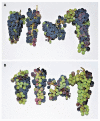Sunburn in Grapes: A Review
- PMID: 33488654
- PMCID: PMC7819898
- DOI: 10.3389/fpls.2020.604691
Sunburn in Grapes: A Review
Abstract
Sunburn is a physiological disorder that affects the visual and organoleptic properties of grapes. The appearance of brown and necrotic spots severely affects the commercial value of the fruit, and in extreme cases, significantly decreases yield. Depending on the severity of the damage and the driving factors, sunburn on grapes can be classified as sunburn browning (SB) or as sunburn necrosis (SN). Sunburn results from a combination of excessive photosynthetically active radiation (PAR) and UV radiation and temperature that can be exacerbated by other stress factors such as water deficit. Fruit respond to these by activating antioxidant defense mechanisms, de novo synthesis of optical screening compounds and heat-shock proteins as well as through morphological adaptation. This review summarizes the current knowledge on sunburn in grapes and compares it with relevant literature on other fruits. It also discusses the different factors affecting the appearance and degree of sunburn, as well as the biochemical response of grapes to this phenomenon and different potential mitigation strategies. This review proposes further directions for research into sunburn in grapes.
Keywords: ROS; antioxidants; mitigation; photooxidation; sunburn browning; sunburn necrosis.
Copyright © 2021 Gambetta, Holzapfel, Stoll and Friedel.
Conflict of interest statement
The authors declare that the research was conducted in the absence of any commercial or financial relationships that could be construed as a potential conflict of interest.
Figures










References
-
- Adams D. O., Liyanage C. (1993). Glutathione increases in grape berries at the onset of ripening. Am. J. Enol. Vitic. 44, 333–338.
-
- Ahmed F. F., Abdel Aal A. M. K., El-Sayed M. A., Sayed H. R. (2013). Protecting red roomy grapevines growing under Minia region conditions from sunburn damage. Stem Cell 4, 15–20.
-
- Allan W. (2003). Winegrape assessment in the vineyard and at the winery. Broadview, Australia: Winetitles Media.
-
- Alleweldt G., Engel M., Gebbing H. (1981). Histologische Untersuchungen an Weinbeeren. Vitis 20, 1–7.
-
- Araújo M., Santos C., Dias M. C. (2018). “Can Young olive plants overcome heat shock?” in Theory and practice of climate adaptation. eds. Alves F., Filho W. L., Azeiteiro U. (Cham, Switzerland: Springer; ), 193–203.
Publication types
LinkOut - more resources
Full Text Sources
Other Literature Sources

